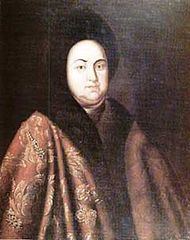Tenure 1689–1698 Religion Eastern Orthodox House House of Romanov | Name Eudoxia Lopukhina | |
 | ||
Issue Tsarevich Alexei PetrovichGrand Duke Alexander PetrovichGrand Duke Paul Petrovich Father Feodor Abramovich Lopukhin Mother Ustinia Bogdanovna Rtishcheva Spouse Peter the Great (m. 1689–1698) Children Alexei Petrovich, Tsarevich of Russia, Grand Duke Alexander Petrovich of Russia Similar People Peter the Great, Alexei Petrovich - Tsarevich, Catherine I of Russia, Natalya Naryshkina, Peter II of Russia | ||
Eudoxia lopukhina 1669 1731
Tsarina Eudoxia Feodorovna Lopukhina (Russian: Evdokíya Fyodorovna Lopuhina; 9 August [O.S. 30 July] 1669, Moscow – 7 September [O.S. 27 August] 1731, Moscow) was the first wife of Peter I of Russia. They married on 27 January 1689 but divorced in 1698. She is the mother of Tsarevich Alexei Petrovich and the paternal grandmother of Peter II of Russia.
Eudoxia was born to Feodor Abramovich Lopukhin and Ustinia Bogdanovna Rtishcheva. Like parents of all the 17th century Tsarinas, they did not belong to the highest aristocracy.
She was chosen as a bride for the Tsar by his mother Natalia Naryshkina primarily on account of Eudoxia's mother's relation to the famous boyar Fyodor Rtishchev. She was crowned Tsarina in 1689 and gave birth to Grand Duke Alexei Petrovich of Russia the following year. She would have two more sons by Peter, Alexander in 1692 and Paul in 1693, but both died during infancy. The Tsar could not stand her conservative relatives and soon abandoned her for a Dutch beauty, Anna Mons. Eudoxia's letters to Peter were full of complaints and exhortations of unrequited love.
In 1696, during his prolonged journey to Western Europe, Peter asked his Naryshkin relatives to persuade Eudoxia to enter a monastery. This could not be effected until 1698, when she was finally banished to the Intercession Convent of Suzdal. The local hegumen, however, allowed her to live there much as a lay woman would. She even found herself a lover, an officer named Stepan Glebov, who later would be executed by quartering.
Gradually, Eudoxia and her son became the centre of opposition to Peter's reforms, primarily from the church officials. In his sermons, Demetrius of Rostov referred to Eudoxia as "our great sovereign" and prophesied her impending return to the throne. This conservative party was shattered by Peter in 1718. During the prosecution of Tsarevich Alexei Petrovich of Russia, all the bishops who supported her were executed, and Eudoxia was transferred to a convent in Ladoga.
After Peter's death and the rise of his second Empress consort Catherine I on the throne, Eudoxia was secretly moved to Shlisselburg fortress near St Petersburg.
In 1727, her grandson Peter II ascended the Russian throne and immediately recalled her to Moscow. She returned to the former capital with a great pomp and was allowed to keep her own court at the Novodevichy Convent until her death in 1731.
